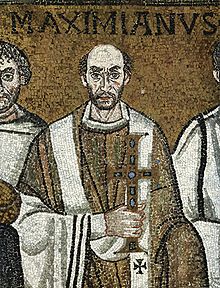Maximianus of Ravenna
Maximianus von Ravenna (* 498 in Pola, today's Pula in Croatia , † February 21 (or 22) February 556 in Ravenna , Italy ) was the first Archbishop of Ravenna and gained recognition and fame as a great promoter of church building activities and as a confidante of Emperor Justinian .
Life
The most important source for this is the Ravennatic historian Andreas Agnellus (* around 805, † after 846) with his work Liber Pontificalis Ecclesiae Ravennatis . Maximianus was born in Pola, in the Roman Colonia Pola of the same name on the Adriatic Sea . There he was initially a deacon . He gained wealth through a treasure trove , which he used throughout his life to build and decorate extensive churches. A church in honor of Our Lady , Santa Maria Formosa in Pola, was the first of these building projects. Agnellus also reports that he gave part of the treasure to Emperor Justinian, who then became aware of him.
Maximianus traveled via Alexandria to Constantinople , where he gained the favor of Emperor Justinian. With his support and influence , Maximianus received the episcopal ordination of Pope Vigilius on October 14, 546 in Patras . He received the pallium and became Archbishop of Ravenna.
Among his activities in Ravenna were the improvement of the formation of the clergy , his contribution to the increase of the church's property (through the acquisition of, for example, the Istrian forest ) and above all the promotion of church building activities. He was involved in the construction of the Church of Sant'Apollinare in Classe and the Basilica of Santo Stefano in Ravenna. The church of San Vitale in Ravenna was completed by Maximianus and consecrated in 547. In addition, he had other churches renovated, expanded or more splendidly decorated. Because of their ivory carvings significant Cathedra of the cathedral of Ravenna is considered the bishop's chair Maximian, displays his monogram . This Maximian cathedra is now in the Museo arcivescovile in Ravenna.
Furthermore, according to Agnellus, Maximian had numerous relics of saints brought to Ravenna, including the remains of the legendary first bishop of Ravenna, St. Apollinaris .
Maximianus was also active as a historian and wrote a chronicle . With the exception of two quotations from Andreas Agnellus, who seems to have used them, nothing of this has survived.
literature
- Lieve Van Hoof: Maximian of Ravenna: Chronica. In: Sacris Erudiri 55, 2016, pp. 259-276.
- Maximianus, S. (5) . In: Johann E. Stadler , Franz Joseph Heim, Johann N. Ginal (Eds.): Complete Lexicon of Saints ... , Volume 4 (M – P), B. Schmid'sche Verlagsbuchhandlung (A. Manz), Augsburg 1875, pp. 353-354 . - (also in the ÖHL )
- Klaus-Gunther Wesseling: Maximian of Ravenna. In: Biographisch-Bibliographisches Kirchenlexikon (BBKL). Volume 5, Bautz, Herzberg 1993, ISBN 3-88309-043-3 , Sp. 1077-1078.
Web links
- Maximianus von Ravenna in the Ecumenical Lexicon of Saints (ÖHL)
Individual evidence
- ^ A b Klaus-Gunther Wesseling: Maximian von Ravenna. In: Biographisch-Bibliographisches Kirchenlexikon (BBKL). Volume 5, Bautz, Herzberg 1993, ISBN 3-88309-043-3 , Sp. 1077-1078.
- ↑ Maximianus, p. (5) . In: Johann E. Stadler , Franz Joseph Heim, Johann N. Ginal (Eds.): Complete Lexicon of Saints ... , Volume 4 (M – P), B. Schmid'sche Verlagsbuchhandlung (A. Manz), Augsburg 1875, pp. 353-354 . - (also in the ÖHL )
- ^ Text, English translation and commentary in Lieve Van Hoof: Maximian of Ravenna: Chronica. In: Sacris Erudiri 55, 2016, pp. 260–267.
| predecessor | Office | successor |
|---|---|---|
| Victor |
Archbishop of Ravenna 546–556 |
Agnellus of Ravenna |
| personal data | |
|---|---|
| SURNAME | Maximianus of Ravenna |
| BRIEF DESCRIPTION | Archbishop of Ravenna |
| DATE OF BIRTH | 498 |
| PLACE OF BIRTH | Pula |
| DATE OF DEATH | February 21, 556 or February 22, 556 |
| Place of death | Ravenna |
